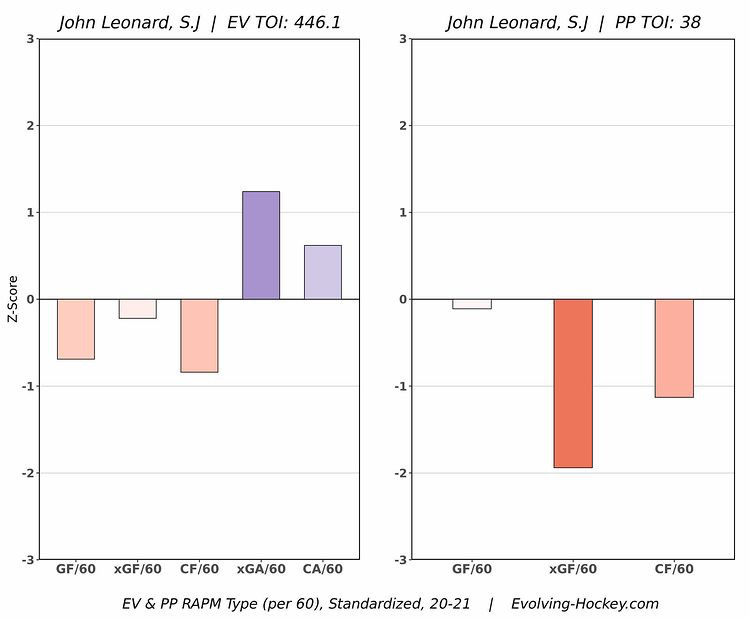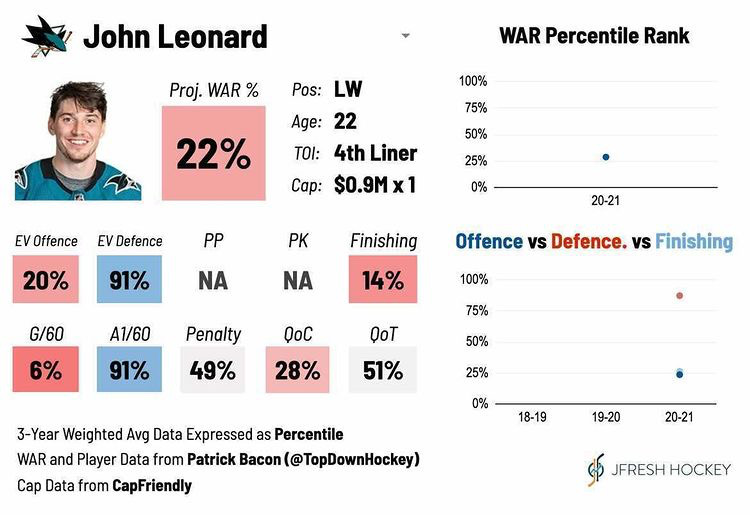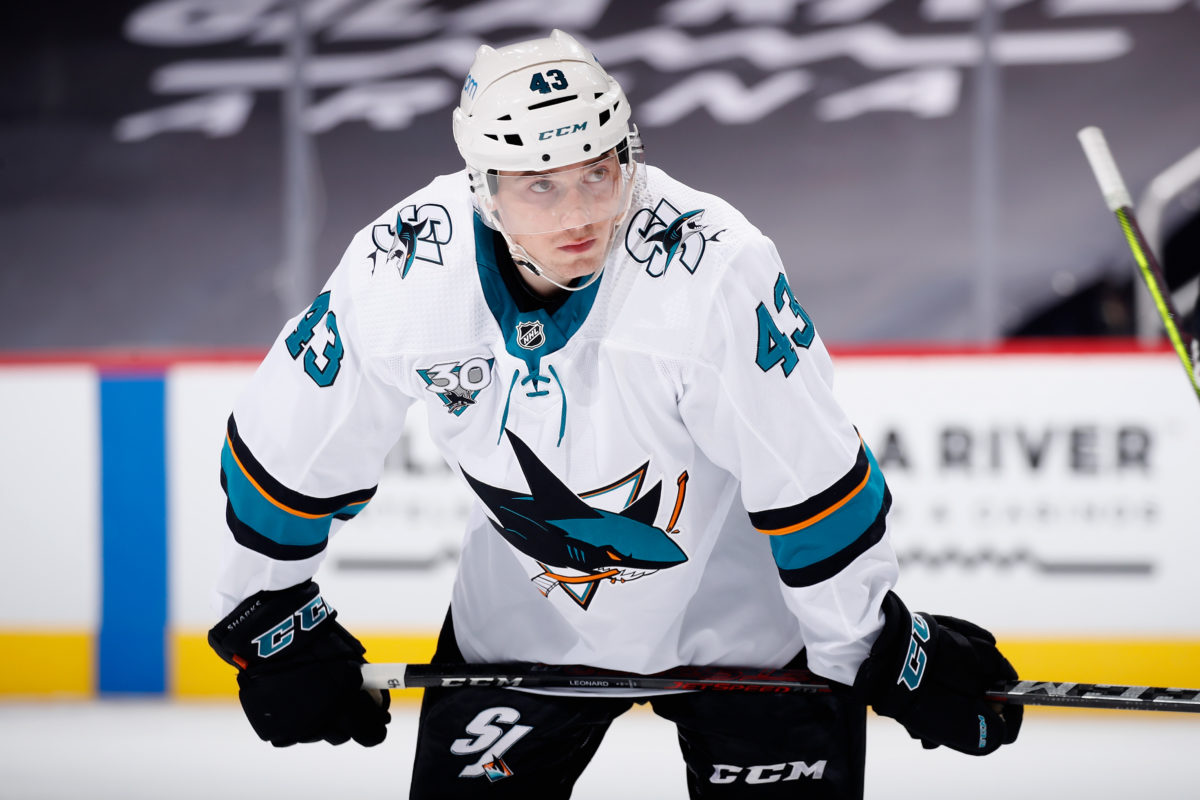With the 182nd overall pick in the 2018 NHL Draft, the San Jose Sharks selected over-aged Green Bay Gamblers forward, John Leonard. This was after his second United States Hockey League season, where the winger notched 19 goals and 34 points in 58 games.
Fast forward a few seasons, Leonard established himself as a quality goal-scorer in his junior year of college. He led the NCAA with 27 goals and 37 points in 33 games in 2019-20, which prompted the Sharks to ink the youngster to a two-year entry-level contract – a move that led him to forgo his senior year at the University of Massachusetts Amherst.
He impressed at training camp. Leonard won a spot in the Sharks’ top-six to start the season and added two assists in his NHL debut. However, his production stalled after that, and eventually, he was bouncing around the bottom six. His most regular linemates were Dylan Gambrell and Ryan Donato and the third line, and Leonard was limited to just three goals and 13 points in 44 games.

Entering this season’s training camp, Leonard will not be competing for a top-six role and might have a tough time securing a spot on the Sharks’ NHL roster. The team has brought in a plethora of forwards, such as Andrew Cogliano, Nick Merkley, Matt Nieto, and Lane Pederson, who could slot in ahead of Leonard in the lineup.
However, now that Evander Kane’s future in the NHL is uncertain, a spot on the wing may free up before opening night. That should be the 23-year-old Leonard’s to lose since he’s proven that he has the skills and IQ to be an NHLer.
Leonard’s Defense is Better Than Most Believe
Leonard’s college success was highlighted by his ability to hit the back of the net with ease. However, his first season in the NHL proved that there is more to his game than offensive production.

Leonard is one of the best defensive forwards on the Sharks. As JFresh’s model indicates, his impact on defense at even strength was in the top 10% of tracked forwards, and this model takes into account teammates, opposition, and their role to determine a player’s impact.
Leonard had a pretty average impact on overall shot attempts (Corsi) and a marginally above average impact on unblocked shot attempts (Fenwick). Relative Corsi for% indicates the percentage difference in shots per team when a player is on the ice vs. when they are off the ice. Leonard’s 0.1% rate shows he was average, but his rate of helping unblocked shot attempts, 1.5%, is a marginal improvement.
He also has a marginally positive impact on the Sharks’ control of expected goals (Relative xGoals%) and a more positive impact than forwards such as Kane, Nieto, Logan Couture, and Noah Gregor. However, head coach Bob Boughner has sheltered Leonard despite these results. The 23-year-old had the highest percentage of offensive zone starts and very few in the defensive zone compared to his teammates. The coaching staff did not trust Leonard despite his strong results defensively.
Leonard started 14.1% of his shifts in the offensive zone and 9.2% of his shifts in the defensive zone. Marcus Sorensen, the team’s worst defensive forward per JFresh’s model, had similar percentages, despite having a worse impact than Leonard. Also, Patrick Marleau had an overall negative impact on the Sharks’ ability to control expected goals, however, the coaching staff sheltered him less; his zone starts were marginally less often in the offensive zone and more in the defensive zone.
Other forwards who started more in the defensive zone and less in the offensive zone than Leonard despite worse results, per JFresh’s model, include Timo Meier, Kevin Labanc, Alexander Barabanov, Matt Nieto, and Dylan Gambrell. The team, for better or worse, trusted veterans to play those defensive shifts, and those decisions often contradicted the tracked data, as the Sharks’ rookie showed well defensively last season.
Leonard’s Offense and Sharks’ Wing Depth Chart
The Sharks are loaded on the wing. Even if Kane does not return, Leonard will have to battle with Timo Meier, Kevin Labanc, Rudolfs Balcers, Alexander Barabanov, Cogliano, Jonathan Dahlén, Nieto, Gregor, Nick Merkley, and other youngsters for a roster spot. However, Leonard should be slotted in above many of them. Of those wingers, he ranks fifth in even-strength points per 60 minutes, behind Kane, Labanc, Balcers, and Meier. Notably, Leonard’s pace of even-strength scoring was above Couture and Barabanov’s.

Leonard also became a quality playmaker, despite his college goal-scoring success. His 1.33 even-strength assists per 60 minutes ranked third on the Sharks behind Kane and Tomas Hertl.
As I see it, Meier, Labanc, and Balcers should be the top-six forwards entering training camp. Without Kane, I expect Dahlen, Leonard, and Barabanov to be competing for his spot. After that, the bottom six gets murky because, as I have mentioned, Boughner prefers veterans over youngsters, despite what the data indicates.
Leonard Must Put it All Together…and He Can
In his first 44 NHL games, Leonard has shown he can tally assists at a similar rate to the team’s best forwards while having a better defensive impact than most of the team’s wingers. At 23, he will need to prove his ability soon.
Leonard’s inability to score last season was an anomaly. His even-strength offense and goal-scoring rates were low because of his poor finishing, with a 5.1% shooting percentage. In fact, MoneyPuck’s model suggests an average shooter can expect to score 2.5 more goals than Leonard tallied. If he could notch that many goals, his rate of goal-scoring would roughly double and the outlook would be much more optimistic.
The University of Massachusetts Amherst alumnus warrants a top-nine role on the Sharks. Some time in the American Hockey League (AHL) would do little for his development. In two games with the San Jose Barracuda last season, Leonard had a goal and an assist before being recalled to the NHL. While he’s not the fastest skater, he could skate end-to-end off a defensive zone faceoff to score in the AHL, which would be impossible at the NHL level.
The Sharks have a quality defensive forward at their disposal, whose playmaking ability has translated well to the NHL, but who couldn’t finish his chances despite a junior and college pedigree of goal-scoring. If Leonard develops the scoring touch from his college career, there would be little missing from his game.
Boughner must learn to trust Leonard and anticipate even more growth now that the youngster has adjusted to the physicality, speed, and schedule of the big league. Look at the strides his college teammate, Mario Ferraro, made in his second professional season. Especially with Kane’s status up in the air, Leonard should be one of the Sharks’ top-nine forwards entering the 2021-22 season.
What did you think of Leonard’s rookie season? Let me know in the comments section!